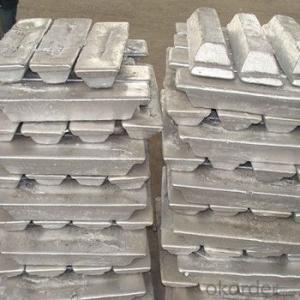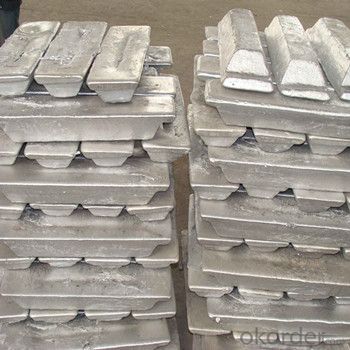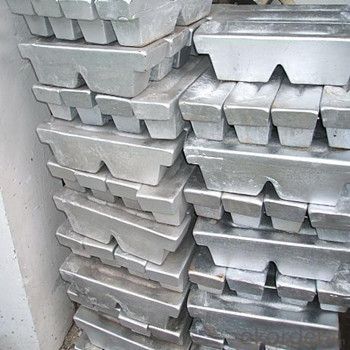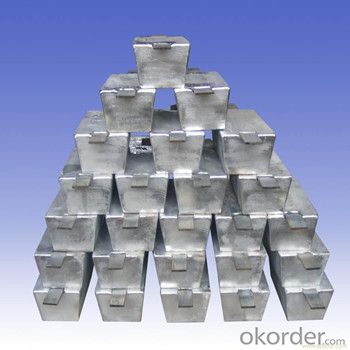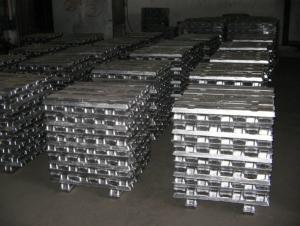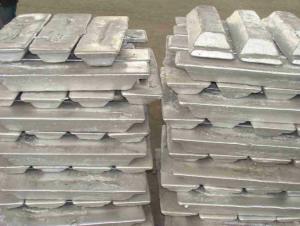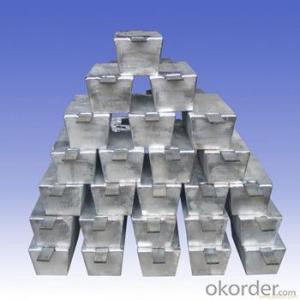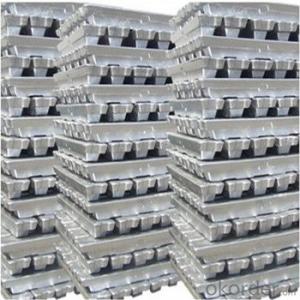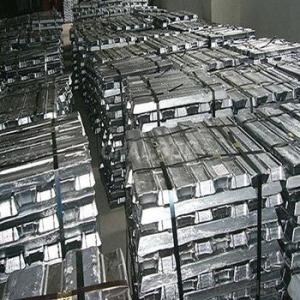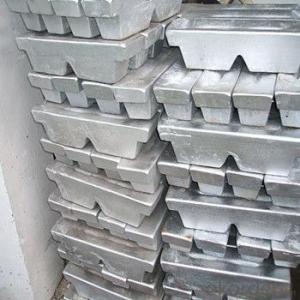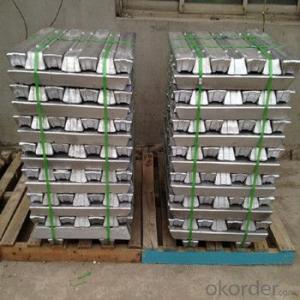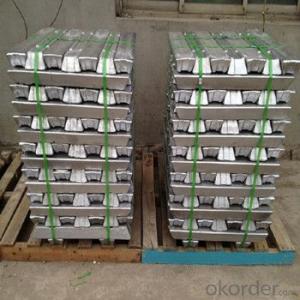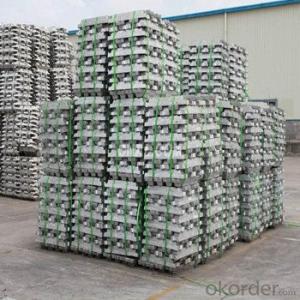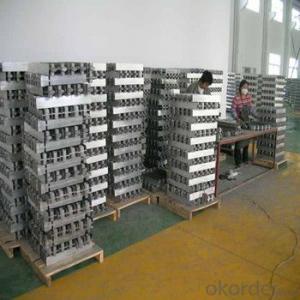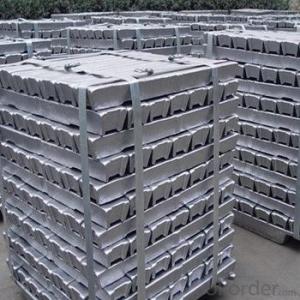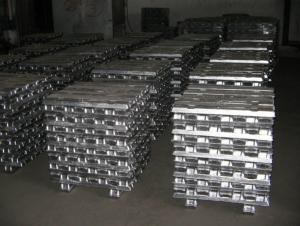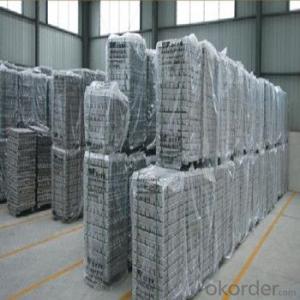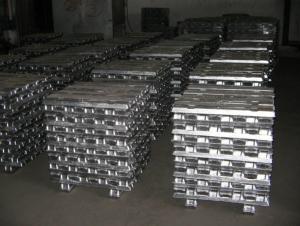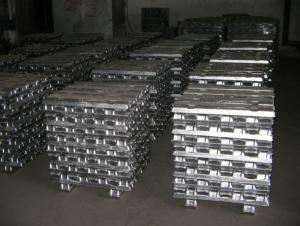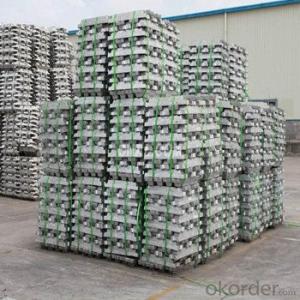Aluminum Ingot With High Purity 99.7% 99.9% With Best Price
- Loading Port:
- China main port
- Payment Terms:
- TT OR LC
- Min Order Qty:
- 1000 m.t
- Supply Capability:
- 10000 m.t/month
OKorder Service Pledge
OKorder Financial Service
You Might Also Like
Pure Aluminum Ingot Used for Industry
1.Structure of Aluminum Ingot Description
An ingot is a piece of material, usually metal, that is cast into a shape suitable for further processing. Insteelmaking, it is the first step among semi-finished casting products. Ingots usually require a second procedure of shaping, such as cold/hot working, cutting, or milling to produce a useful final product. Non-metallic and semiconductor materials prepared in bulk form may also be referred to as ingots, particularly when cast by mold based methods.
2.Main Features of the Aluminum Ingot
•High Purity
•High strength
•Fast melting
•Best price
•Good after-service
3. Aluminum Ingot Images


4. Aluminum Ingot Specification
Grade | Chemical Composition % | |||||||||
Al≥ | impurities ≤ | |||||||||
Si | Fe | Cu | Ga | Mg | Zn | Mn | others | Sum | ||
Al99.9 | 99.90 | 0.50 | 0.07 | 0.005 | 0.02 | 0.01 | 0.025 | - | 0.010 | 0.10 |
Al99.85 | 99.85 | 0.80 | 0.12 | 0.005 | 0.03 | 0.02 | 0.030 | - | 0.015 | 0.15 |
Al99.7 | 99.70 | 0.10 | 0.20 | 0.010 | 0.03 | 0.02 | 0.030 | - | 0.030 | 0.30 |
Al99.6 | 99.60 | 0.16 | 0.25 | 0.010 | 0.03 | 0.03 | 0.030 | - | 0.030 | 0.40 |
Al99.5 | 99.50 | 0.22 | 0.30 | 0.020 | 0.03 | 0.05 | 0.050 | - | 0.030 | 0.50 |
Al99.00 | 99.00 | 0.42 | 0.50 | 0.020 | 0.03 | 0.05 | 0.050 | - | 0.050 | 1.00 |
5.FAQ of Aluminum Ingot
We have organized several common questions for our clients,may help you sincerely:
①How about your company?
A world class manufacturer & supplier of castings forging in carbon steel and alloy steel,is one of the large-scale professional investment casting production bases in China,consisting of both casting foundry forging and machining factory. Annually more than 8000 tons Precision casting and forging parts are exported to markets in Europe,America and Japan. OEM casting and forging service available according to customer’s requirements.
②How to guarantee the quality of the products?
We have established the international advanced quality management system,every link from raw material to final product we have strict quality test;We resolutely put an end to unqualified products flowing into the market. At the same time, we will provide necessary follow-up service assurance.
③How long can we receive the product after purchase?
In the purchase of product within three working days, We will arrange the factory delivery as soon as possible. The pecific time of receiving is related to the state and position of customers.Commonly 7 to 10 working days can be served.
- Q: How many tons of alumina for a ton of aluminum ingot, alumina and electrolytic aluminum what is the difference?
- Alumina is an oxide of aluminum, a compound, an element of aluminum.
- Q: How are aluminum ingots used in the production of building facades?
- Aluminum ingots are commonly used in the production of building facades as they serve as the raw material for the manufacturing of aluminum panels or cladding. These ingots are melted down and then extruded or rolled into thin sheets, which are then cut, shaped, and installed to create the outer layer of a building's façade. Aluminum's lightweight, corrosion-resistant, and malleable properties make it an ideal choice for building facades, providing durability, aesthetic appeal, and energy efficiency to the structure.
- Q: Can the art knife cut the aluminum ingot?
- Yes, choose reasonable parameters according to the hardness of the material
- Q: What is the role of aluminum ingots in the production of cans?
- The production of cans relies heavily on aluminum ingots, which serve as the primary raw material in the manufacturing process. These ingots are melted and then shaped into the desired size and form of the can. Aluminum is the chosen material for cans due to its exceptional properties. Its lightweight nature makes transportation and handling easier. Additionally, it is highly durable and resistant to corrosion, ensuring the cans effectively safeguard their contents. After the aluminum ingots are melted and shaped, they undergo several processes to transform into the final can. This involves shaping, forming, and coating to ensure strength and withstand the pressure exerted by carbonated beverages. Moreover, aluminum ingots enable convenient recycling of cans. Aluminum is a highly recyclable material, and incorporating ingots in the production process guarantees that cans can be recycled and reused multiple times without compromising quality. In conclusion, aluminum ingots play a crucial role in can production, providing the essential raw material for lightweight, durable, and recyclable containers extensively used in the beverage industry.
- Q: Why is there a lot of glue after the aluminium ingot is melted?
- You were being set up (ingot tundish ash, suggest that you get some cut sampling, look at the middle consistency). It is a greater loss, only the ash picked up, and then put the iron pot with sodium nitrate, pulverized coal stir, the question raised by this al DNA. The most after I have a advice, please do not use zinc chloride, it is toxic, a few days down near all the plants will die, will seriously affect the health!
- Q: What are the challenges in recycling scrap aluminum ingots?
- One of the challenges in recycling scrap aluminum ingots is the presence of impurities and contaminants. These impurities can affect the quality of the recycled aluminum and may require additional processing steps to remove them effectively. Additionally, the collection and sorting of scrap aluminum can be challenging due to its widespread use in various industries, leading to difficulties in sourcing sufficient quantities of clean and uncontaminated scrap material. Finally, the energy-intensive nature of aluminum production and recycling poses a challenge in terms of the environmental impact and cost-effectiveness of the recycling process.
- Q: What are the limitations of using aluminum ingots in high-temperature applications?
- One limitation of using aluminum ingots in high-temperature applications is its relatively low melting point of around 660 degrees Celsius. This restricts its use in environments where temperatures exceed this threshold, as the ingots can melt and lose their structural integrity. Additionally, aluminum has a high coefficient of thermal expansion, which means it expands significantly when exposed to heat. This expansion can lead to dimensional instability and potential damage to the surrounding structures or components. Moreover, aluminum has lower strength and hardness compared to other metals like steel or titanium, which may make it less suitable for high-temperature applications that require superior mechanical properties.
- Q: How to add zinc when producing aluminium ingot?
- Zinc can be directly mixed into the furnace when melting scrap aluminum. In fact, there are many pieces of zinc or zinc aluminum alloy in the waste scrap aluminum. If the ingredients are counted, sometimes they need not be added. The key is to have the method of checking the ingredients. Preferably a spectrum machine.
- Q: What are the challenges in sourcing sustainable aluminum ingots?
- Sourcing sustainable aluminum ingots presents various challenges. One of the primary obstacles involves ensuring that the aluminum is produced in an environmentally-conscious manner. This entails minimizing energy consumption and carbon emissions linked to the production process. Many aluminum smelters still rely on fossil fuels for energy, which has a significant detrimental effect on the environment. Another challenge lies in verifying the origin of the aluminum. It is crucial to guarantee that the raw materials used in ingot production are ethically sourced and not associated with deforestation, human rights abuses, or conflict zones. This necessitates a robust and transparent supply chain capable of tracing the aluminum back to its source. Additionally, the issue of waste and recycling needs to be addressed. Aluminum is highly recyclable, but significant amounts of aluminum waste still end up in landfills. Encouraging and incentivizing aluminum recycling is vital to mitigate the environmental impact of its production. Furthermore, the availability of sustainable aluminum ingots can be limited. Not all aluminum producers have adopted sustainable practices, resulting in a lack of supply in certain regions or industries. This poses a consistent challenge for businesses seeking to source sustainable aluminum ingots. Overall, addressing these challenges is essential to promote an environmentally-friendly and responsible aluminum industry. By striving for sustainable sourcing practices, we can minimize the environmental impact of aluminum production and contribute to a more sustainable future.
- Q: Can aluminum ingots be welded?
- Yes, aluminum ingots can be welded.
Send your message to us
Aluminum Ingot With High Purity 99.7% 99.9% With Best Price
- Loading Port:
- China main port
- Payment Terms:
- TT OR LC
- Min Order Qty:
- 1000 m.t
- Supply Capability:
- 10000 m.t/month
OKorder Service Pledge
OKorder Financial Service
Similar products
Hot products
Hot Searches
Related keywords
